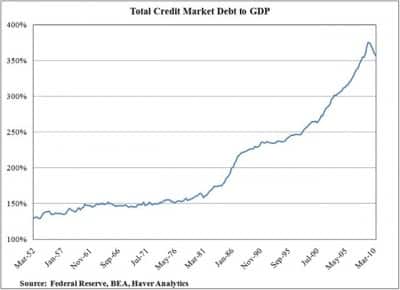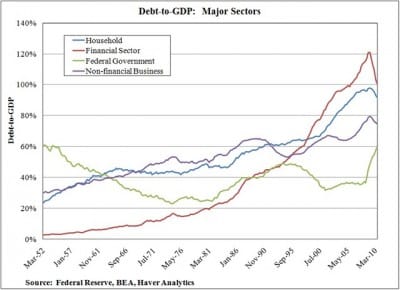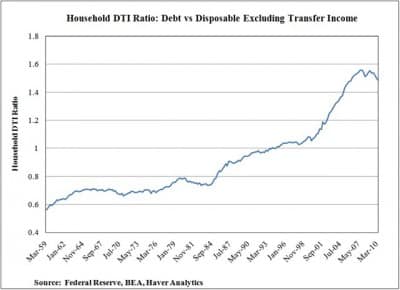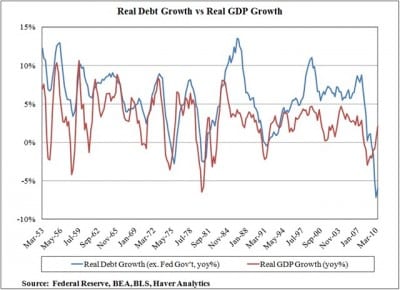Charts of the Day: The New Z.1 is Out!
Last Friday was a Z.1 Flow of Funds day, always a fun day. The 137 page report from the Federal Reserve features data for the second quarter of 2010. Total credit market debt outstanding grew slightly during the quarter, rising just $14.7 billion to $52.1 trillion. A chart that we like to run puts these large numbers in perspective, showing the total debt-to-GDP ratio over a period of nearly 60 years.
This ratio has been declining for 5 consecutive quarters, but the chart shows you how much more deleveraging we have to do before we revert to anything resembling “normal.” Holding GDP constant, a return to 300% debt-to-GDP would require total debt to fall by more than $8.3 trillion (or about 57% of current GDP). Using the same methodology, the return to a ratio of 250% (last seen in 1997) would require a fall in total debt outstanding of $15.6 trillion, more than a full year’s worth of GDP.
Despite the small rise in total debt outstanding during the second quarter, a look at some of the underlying sectors is instructive.
Unsurprisingly, the only major sector with significant debt growth during the quarter was the Federal Government. The household, financial, and non-financial business sectors continue their deleveraging.
Household debt, which peaked very close to 100% of GDP only a few short quarters ago, now stands at 92.1% of GDP. We use the Flow of Funds data to create another household debt chart, showing debt as a percentage of household income (also known as a DTI ratio). For household income, we use disposable personal income less transfer receipts.
Low interest rates obviously support a higher level of debt relative to income (this is true for all sectors), but clearly this ratio can’t “grow to the sky.” Much of this debt growth was driven by the mortgages associated with the housing bubble. Holding income constant, a reversion to the pre-bubble ratio level of 1.25 would indicate a decline in household debt of roughly $2.1 trillion. After peaking in the third quarter of 2008, household debt has only declined $493 billion so far.
We’ll be the first to admit to our laser-like focus on debt. There is a good reason: as we’ve demonstrated before, debt growth drives GDP growth.
A few themes that run through all of the above charts:
·Notice how the economy recovered from the previous double-dip recessions in the early 1980’s, and why the roughly 20 years of growth we experienced afterward were so strong: impressive real private debt expansion.
·The current expansion has been sluggish because it was driven by government stimulus and inventory restocking, and has been fighting the substantial headwind of real private debt contraction.




Comments are closed.